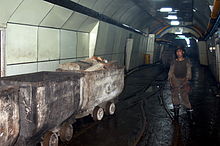Safety and Health in Mines Convention, 1995
[3] Due to the hazardous conditions that are present in mines, the governing body of the International Labor Organization (ILO) expressed the need for a convention regarding the health and safety of miners.
The underground nature of the workplace often exposes workers to numerous hazards, such as harmful gases, falling debris, limited visibility, and uneven/dangerous terrain.
[9] The 42nd President of the United States, Bill Clinton, signed the Convention on January 5, 2001, with guidance from the Secretary of Labor, Alexis Herman.
This division, the Mine Safety and Health Administration (MSHA), has been an agency with a mission to promote a safe and healthy workplace for miners by preventing injury and disease since 1977.
The Mine Act sets various standards intended to reduce fatal accidents and minimize health hazards.
[11] The disease black lung, which largely affects miners, is being addressed by the MSHA in hopes of reducing its prevalence in the United States.
Similarly, the laws outlined in the Convention aim to lower the number of individuals with diseases obtained from the mining workplace.
By ratifying the Convention, the United States could reach out to other countries for failing to enforce the applicable laws, which would hold other nations accountable.
[15] In addition, the ratification helped make the United States mining industry more competitive in the global economy.
During the Soma disaster, a commission from the International Labor Organization was sent to discuss miners' health and safety with Turkish officials.
In addition, Turkey claimed to be in full compliance with European Union standards and had laws even more advanced than the ILO Convention.
[16] IndustriALL, a global union that represents 50 million workers from 146 countries, urged Turkey to swiftly ratify the Convention following the Soma disaster.
They claim that the best way to accomplish this is by having countries ratify the Convention and fully implement the laws and safety regulations contained within it.
Turkey was largely hesitant to begin ratification processes due to employer backlash over the cost of upholding the Convention's rules and regulations.
[19] The United States Federal government has paid 45 billion dollars in compensation to miners and their dependents affected by the illness.Despite this, with modern safety measures, pneumoconiosis is easily preventable, and a properly ventilated mine equipped with modern tools presents a significantly lower risk to the contraction of the disease.
Finally, Article 5 requires that countries publish statistics on occupational disease (including black lung).
Given its policy implications, the project has increased social partners' awareness of the need to take steps to improve occupational safety, prevent work accidents, and fully implement health protection measures.





